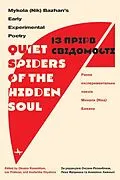This bilingual Ukrainian-English collection brings together the most interesting experimental works by Mykola (Nik) Bazhan, one of the major Ukrainian poets of the twentieth century. As he moved from futurism to neoclassicism, symbolism to socialist realism, Bazhan consistently displayed a creative approach to theme, versification, and vocabulary. Many poems from his three remarkable early collections (1926, 1927, and 1929) remain unknown to readers, both in Ukraine and the West. Because Bazhan was later forced into the straitjacket of officially sanctioned socialist realism, his early poetry has been neglected. This collection makes these outstanding works available for the first time.
Autorentext
Mykola Bazhan (1904-1983), one of the most important representatives of Ukrainian literary renaissance of the 1920s, was born into an educated family of Polish-Lithuanian roots in Kamyanets'-Podil's'kyi in Ukraine. Bazhan emerged as a futurist; however, in the 1920s and early 1930s he embraced romantic Expressionism, with frequent references to the turbulence of Ukrainian history. During his extensive career spanning some six decades, Bazhan was prolific as a poet, literary critic, translator, editor, art collector, and a political and cultural figure. Despite the fact that Bazhan not only survived the purges but eventually became an influential political figure, his early works continued to be repressed until the early 1990s.
Lev Fridman is a Speech-Language Pathologist based in New York City. He has facilitated translation projects and publications, and his own writings and translations have appeared in Ugly Duckling Press, Odessa Review, and The Café Review. His most recent research has focused on the literary legacy of Mykola Bazhan.
Anzhelika Khyzhnya is a scholar and journalist. She holds an MA in Slavic Languages and Literature, and is a PhD candidate at the University of California, Berkeley. Her research interests include linguistic aspects of early 19th century Russian and Ukrainian prose, Ukrainian poetry of the 1920s, and the relationship between literature and the visual arts.
Inhalt
Table of Contents
Acknowledgments
Preface Oksana Rosenblum
Introduction: "The Ukrainian Avant-Garde and Its Roots: The Poetics of Mykola (Nik) Bazhan" Galyna Babak
COLLECTIONS
/The Seventeenth Patrol (1926)
Translator's Essay: "Jumping the Corral Fence" Svetlana Lavochkina
/ Trooper's Song / Imobe of Galam
/The Sculpted Shadow (1927)
Translator's Essay: "Mykola Bazhan's The Sculpted Shadow: Echoes of Acmeism" Dr. Amelia Glaser
/ An Autumn Road / Horseshoes / A Moment in the Night / Indistinct Sound / Fern / The Blood of the Captive Women / Lovage - / Love Potion / The Infinite Road
/Edifices (1929)
/ The Road / A Night Cruise / To My Friend / Foxtrot / Elegy for Circus Attractions / Edifices: / Cathedral, / Archway, / Building / Conversation of Hearts
Short Poems (1923-1927)
Translators' Essays Ostap Kin, Ainsley Morse, Mykyta Tyshchenko Seán Monagle
/ Trumpet of Swarm - / Ruhr-March - / Aero-March / Hops of Green Legs / Circus
Long Poems (1929-1930)
/ Night of Hoffmann / Ghetto in Uman'
Translator's Essay Prof. George G. Grabowicz
/ Blind Bards
Prose (1927)
Translator's Essay Dr. Roman Ivashkiv
: / Meeting at the Crossroad Station: A Conversation Among the Three (1927)
Afterward: "From the Whirlpool of Creativity to Living on the Edge of a Psychological Abyss: Mykola Bazhan in the 1920s and 1930s" Dr. Eleonora Solovey
Information about the editors, translators, and contributing writers Illustrations Index
